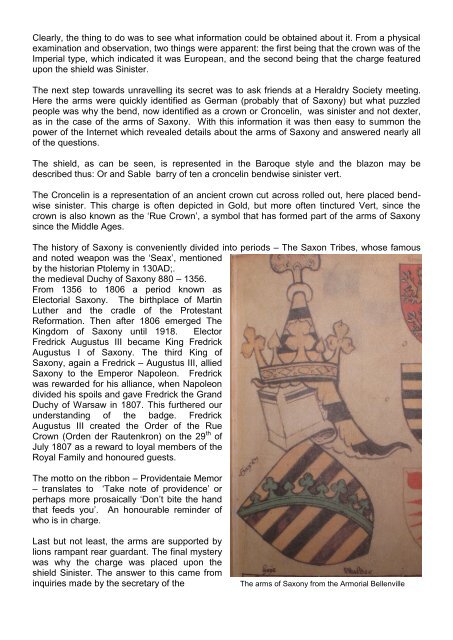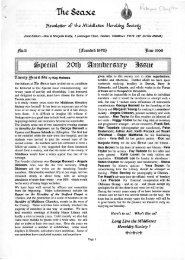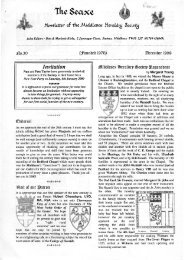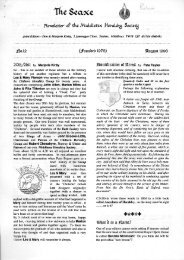No.57 - Middlesex Heraldry Society
No.57 - Middlesex Heraldry Society
No.57 - Middlesex Heraldry Society
You also want an ePaper? Increase the reach of your titles
YUMPU automatically turns print PDFs into web optimized ePapers that Google loves.
Clearly, the thing to do was to see what information could be obtained about it. From a physical<br />
examination and observation, two things were apparent: the first being that the crown was of the<br />
Imperial type, which indicated it was European, and the second being that the charge featured<br />
upon the shield was Sinister.<br />
The next step towards unravelling its secret was to ask friends at a <strong>Heraldry</strong> <strong>Society</strong> meeting.<br />
Here the arms were quickly identified as German (probably that of Saxony) but what puzzled<br />
people was why the bend, now identified as a crown or Croncelin, was sinister and not dexter,<br />
as in the case of the arms of Saxony. With this information it was then easy to summon the<br />
power of the Internet which revealed details about the arms of Saxony and answered nearly all<br />
of the questions.<br />
The shield, as can be seen, is represented in the Baroque style and the blazon may be<br />
described thus: Or and Sable barry of ten a croncelin bendwise sinister vert.<br />
The Croncelin is a representation of an ancient crown cut across rolled out, here placed bend-<br />
wise sinister. This charge is often depicted in Gold, but more often tinctured Vert, since the<br />
crown is also known as the „Rue Crown‟, a symbol that has formed part of the arms of Saxony<br />
since the Middle Ages.<br />
The history of Saxony is conveniently divided into periods – The Saxon Tribes, whose famous<br />
and noted weapon was the „Seax‟, mentioned<br />
by the historian Ptolemy in 130AD;.<br />
the medieval Duchy of Saxony 880 – 1356.<br />
From 1356 to 1806 a period known as<br />
Electorial Saxony. The birthplace of Martin<br />
Luther and the cradle of the Protestant<br />
Reformation. Then after 1806 emerged The<br />
Kingdom of Saxony until 1918. Elector<br />
Fredrick Augustus III became King Fredrick<br />
Augustus I of Saxony. The third King of<br />
Saxony, again a Fredrick – Augustus III, allied<br />
Saxony to the Emperor Napoleon. Fredrick<br />
was rewarded for his alliance, when Napoleon<br />
divided his spoils and gave Fredrick the Grand<br />
Duchy of Warsaw in 1807. This furthered our<br />
understanding of the badge. Fredrick<br />
Augustus III created the Order of the Rue<br />
Crown (Orden der Rautenkron) on the 29 th of<br />
July 1807 as a reward to loyal members of the<br />
Royal Family and honoured guests.<br />
The motto on the ribbon – Providentaie Memor<br />
– translates to „Take note of providence‟ or<br />
perhaps more prosaically „Don‟t bite the hand<br />
that feeds you‟. An honourable reminder of<br />
who is in charge.<br />
Last but not least, the arms are supported by<br />
lions rampant rear guardant. The final mystery<br />
was why the charge was placed upon the<br />
shield Sinister. The answer to this came from<br />
inquiries made by the secretary of the The arms of Saxony from the Armorial Bellenville














